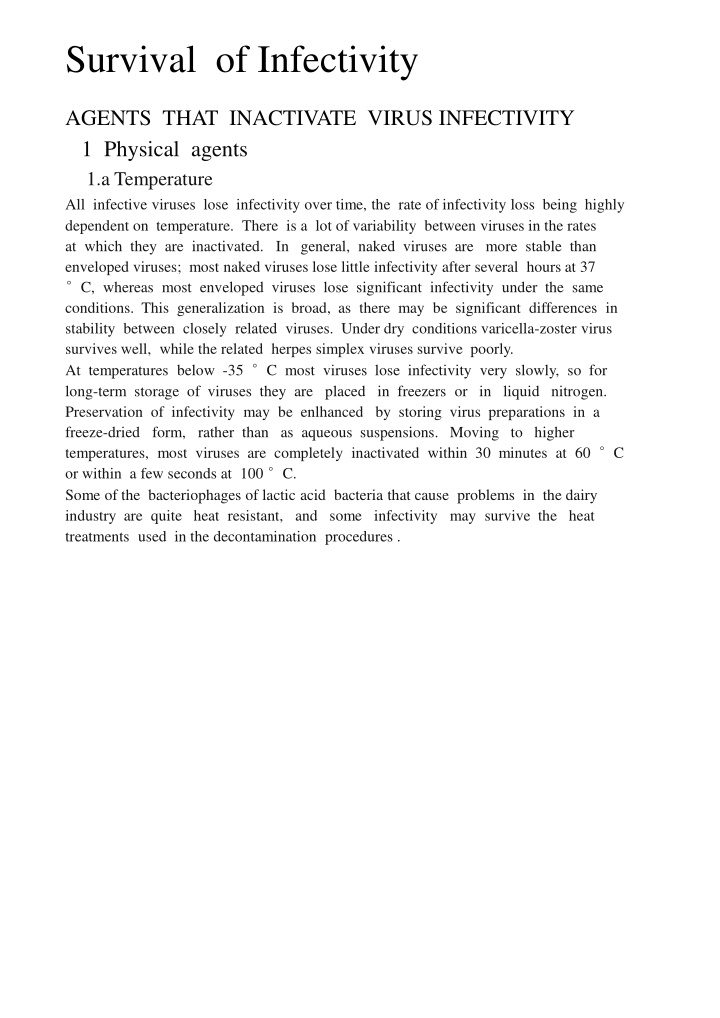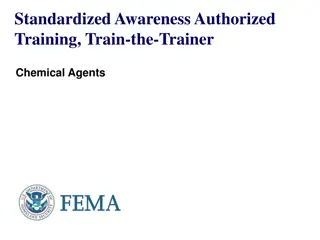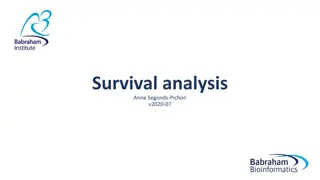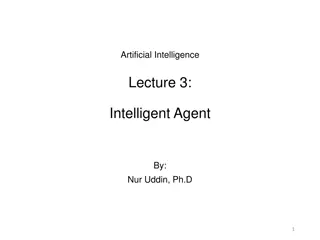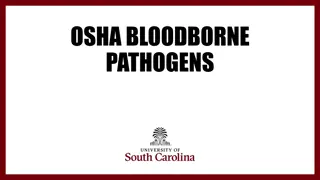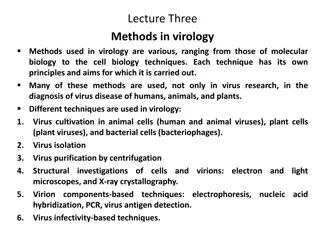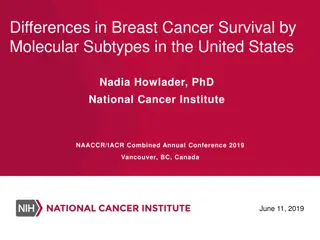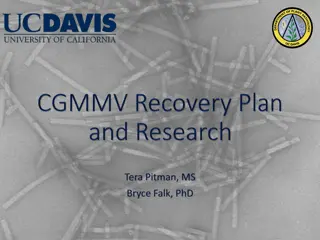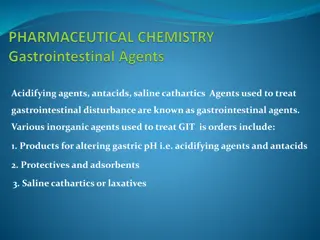Survival of Infectivity: Physical Agents and Virus Stability
All viruses lose infectivity over time, with temperature playing a crucial role. Heat, radiation, and chemicals can all inactivate virus infectivity at varying rates. Understanding the factors affecting virus stability is essential for various applications.
Download Presentation

Please find below an Image/Link to download the presentation.
The content on the website is provided AS IS for your information and personal use only. It may not be sold, licensed, or shared on other websites without obtaining consent from the author.If you encounter any issues during the download, it is possible that the publisher has removed the file from their server.
You are allowed to download the files provided on this website for personal or commercial use, subject to the condition that they are used lawfully. All files are the property of their respective owners.
The content on the website is provided AS IS for your information and personal use only. It may not be sold, licensed, or shared on other websites without obtaining consent from the author.
E N D
Presentation Transcript
Survival of Infectivity AGENTS THAT INACTIVATE VIRUS INFECTIVITY 1 Physical agents 1.a Temperature All infective viruses lose infectivity over time, the rate of infectivity loss being highly dependent on temperature. There is a lot of variability between viruses in the rates at which they are inactivated. In general, naked viruses are more stable than enveloped viruses; most naked viruses lose little infectivity after several hours at 37 C, whereas most enveloped viruses lose significant infectivity under the same conditions. This generalization is broad, as there may be significant differences in stability between closely related viruses. Under dry conditions varicella-zoster virus survives well, while the related herpes simplex viruses survive poorly. At temperatures below -35 C most viruses lose infectivity very slowly, so for long-term storage of viruses they are placed in freezers or in liquid nitrogen. Preservation of infectivity may be enlhanced by storing virus preparations in a freeze-dried form, rather than as aqueous suspensions. Moving to higher temperatures, most viruses are completely inactivated within 30 minutes at 60 C or within a few seconds at 100 C. Some of the bacteriophages of lactic acid bacteria that cause problems in the dairy industry are quite heat resistant, and some infectivity may survive the heat treatments used in the decontamination procedures .
The virions of some viruses, such as hepatitis A virus (HAV) and parvoviruses, are exceptionally heat stable. Data for the minute virus of mice (a parvovirus) indicate some infectivity surviving after 60 minutes at 80 C (Figure ). Figure Inactivation of minute virus of mice infectivity in water at 70, 80, and 90 C. e 10"* t: (mimu nn Exceptions to the generalization concerning the stability of naked and enveloped virions include those of hepatitis B virus (HBV), which are enveloped but have high stability, and those of poliovirus, which are naked but have low stability. Interestingly, HAV (heat-stable virions) and poliovirus (heat-labile virions) are both members of the family Picornaviridae, so, as with the herpesviruses, there is not always consistency in the degree of stability between viruses with similar structures. The fact that virus preparations lose infectivity means that special precautions have to be taken to minimize infectivity loss during transport and storage of live vaccines, such as polio, mumps, measles, and rubella. These precautions include a "cold chain" of containers and vehicles that are refrigerated and/or insulated. This adds considerably to the expense of vaccination programs. The rate of infectivity loss depends on the nature of the medium containing the virus. The presence of proteins, fats, glycerol, or certain salts may protect infectivity. Magnesium ions reduce the rate of inactivation of many RNA viruses, including poliovirus, so magnesium chloride is added to live polio vaccines to extend their shelf life. The most heat-resistant viruses known are those that infect the thermophilic prokaryotes that inhabit hot springs. The optimum temperature for the growth of many of the hosts of these viruses is around 85 C. Prions are also remarkably heat resistant.
1.b Radiation Some forms of radiation inactivate virus infectivity because they damage nucleic acids; for exaMple, X-rays, gamma rays, and ultraviolet rays cause breaks in nucleic acids. Ultraviolet rays also cause other types of damage to nucleic acids, including the formation of thymine dimers in dsDNA (Figure ). The thymine-adenine hydrogen bonds at two adjacent base pairs are broken and covalent bonds are formed between the two thymine residues. Figure Formation of a thymine dimer in dsDNA. T T II ii II rII G A .\ A II l' Sunlight inactivates virus infectivity because of its ultraviolet component. A practical aspect of this is the rapid inactivation by sunlight of baculoviruses applied to crops and forests as insecticides. Chemical agents Chemicals that inactivate virus infectivity do so with similar kinetics to physical agents, with either one or two inactivation rates (Figure ). When soMe inactivation data are plotted the initial part of the graph has a small shoulder before the straight line. This could be due to a delay while the chemical reaches its target in the virion. Many chemicals can inactivate virus infectivity, but for many of them the inactivation target(s) are uncertain. We now consider the effects of hydrogen ion concentration (pH) and of a variety of other chemical agents on virus infectivity. 2.a Acids and alkalis Most viruses are fairly stable at pH values between 5 and 9, but at more extreme pH values virions may undergo conformational changes and rates of infectivity loss usually increase. At high pH values both nucleic acids and proteins can be daMaged. Alkali, in the form of dilute sodiuM hydroxide (soMetimes in combination with steaM ), is used to disinfect Manufacturing vessels and tools in the pharmaceutical industry. The infectivity of some viruses is inactivated at low pH values as a result of alterations to surface proteins. Viruses that infect humans and other mammals via the gastrointestinal route, however, are relatively stable at low pH values. These viruses, which include rotaviruses , have to survive in the stomach
contents, which are commonly at a pH value between 1 and 2. Furthermore, their virions must be able to withstand the sudden increase in pH when they are moved from the stomach to the intestine (pH about 7.5), and they must be resistant to inactivation by bile salts and proteolytic enzymes. HAV and many enteroviruses infect their hosts via the gastrointestinal tract. These viruses a re picornaviruses , but, when com pared to those picornaviruses (such as rhinoviruses and aphthoviruses) that infect their hosts via other routes, their virions are much more acid-resistant. It can be seen in Figure that HAV infectivity can still be detected after 6 minutes at pH 3.3 at a temperature of 85 C; thus, HAV is an example of a virus with high resistance to inactivation by both heat and acid.. Figure . Inactivation of hepatitis A virus infectivity at three pH values at 85 C. 5 Phenol, which is a weak acid, destroys the capsids of virions without altering nucleic acids. It is commonly used in the laboratory to extract nucleic acids from virions. b. Hypochlorite One of the most widely used disinfectants is hypochlorite. Both the hypochlorite ion (OCI-) and the undissociated hypochlorous acid (HOCI) are excellent disinfectants; they act by oxidizing organic molecules, such as proteins. Hypochlorite ions are either supplied as sodium hypochlorite or they are generated by dissolving chlorine gas in water. The latter process is used to treat drinking water supplies and swimming pool water. Sodium hypochlorite is one of the disinfectants used in the dairy industry to control phages of lactic acid bacteria such as Lactobacillus spp. The inactivation of a Lactobacillus phage at four concentrations of hypochlorite is shown in Figure .
At free chlorine concentrations 100-3 00 ppm there were slower rates of inactivation for a small percentage of the virions. Figure. Inactivation of Lactobacillus phage BYM by hypochlorite. The concentrations are shown as parts per million (ppm) of free chlorine. The phage suspensions were at 25 C and pH 7. 1 ppm OOppm Tim minute) c. Aldehydes and alcohols Formaldehyde and glutaraldehyde damage both enveloped and non-enveloped virions. Formaldehyde cross-links proteins and reacts with amino groups in nucleic acids; it is used to destroy the infectivity of poliovirus and other viruses for use in inactivated vaccines. Glutaraldehyde is useful for disinfecting metal surfaces because it is non-corrosive. Ethanol and isopropyl alcohol are used as general purpose disinfectants and in waterless hand washes. d. Lipid solvents Detergents and many organic solvents, such as chloroform, destroy the infectivity of enveloped viruses by removing their lipid mem branes and associated glycoproteins. Detergents and solvents are used in the preparation of clotting factors and other blood products to destroy enveloped viruses (particularly HIV, HBV, and HCV) that may be present in pooled blood donations. Lipid solvents may also damage virions with internal lipid, such as the corticoviruses and the tectiviruses . Quaternary ammonium compounds are cationic and disrupt virion envelopes. Several of them are used as disinfectants, especially chlorhexidine gluconate, which is widely used in health care institutions. Anionic detergents, such as sodium dodecyl sulfate, disrupt virion envelopes and capsids.
